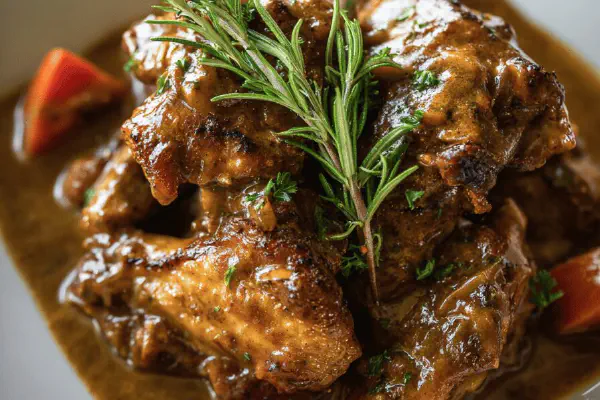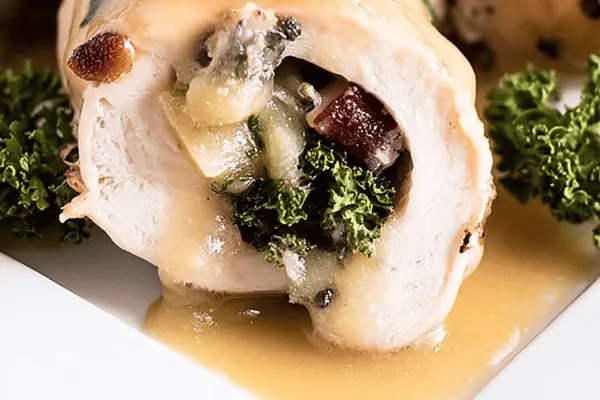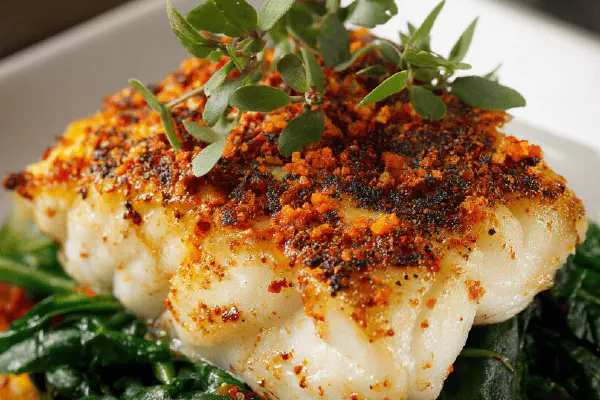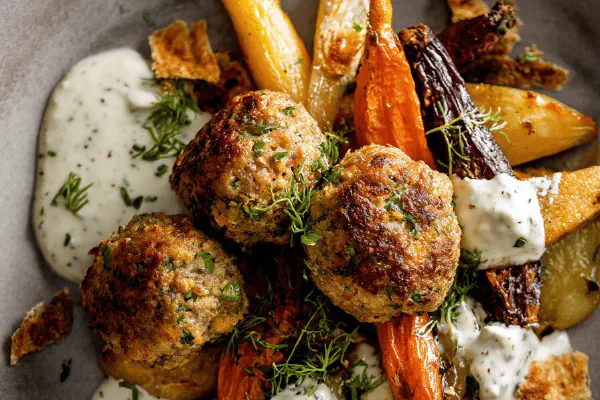Honey Mustard Chicken Thighs
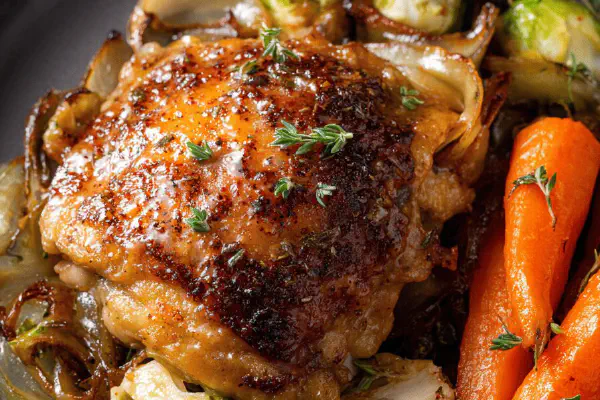
By Emma
Certified Culinary Professional
Ingredients
- 6 whole chicken thighs skin-on
- 300 g trimmed Brussels sprouts
- 2 medium onions sliced thick
- 450 g mini carrots
- 45 ml olive oil
- 30 ml avocado oil
- 15 ml honey
- 25 ml Dijon mustard
- 15 ml whole grain mustard
- 1 tsp smoked paprika
- 1/2 tsp black pepper freshly cracked
- 2 cloves garlic minced finely
- 1/2 tsp turmeric ground
- 1 tbsp fresh thyme leaves
- Salt coarse sea salt
- 15 ml ketchup
About the ingredients
Method
Honey Mustard Sauce
- Preheat oven to 190 C (375 F). Place rack mid-level to allow good air circulation. Start with heavy-bottomed small skillet over medium-high. Heat olive oil until it shimmers but not smoking. Toss in onions and garlic; hear them sizzle, soften, edges just starting to brown. Stir in smoked paprika and turmeric; aroma deepens in seconds but don’t burn. Remove from heat. Stir in honey, Dijon and grainy mustard, ketchup, fresh thyme, cracked pepper. Sauce thickens, glossy. Set aside to keep warm.
Prep Chicken and Vegetables
- Rub chicken thighs with salt and black pepper, skin scored lightly to release fat while roasting. Use olive oil or avocado oil on skin for better crisp. Arrange thighs skin-side up in 33x23cm baking dish; avoid crowding for even crispiness. In separate baking dish, toss Brussels sprouts halved, thick onion slices, and whole baby carrots with avocado oil, salt, and pepper. Coating vegetables evenly—don’t drown them—helps roasting to caramelize, not steam.
Cooking
- Place both dishes side-by-side in oven but slightly offset so heat circulates evenly. Roast vegetables about 40 minutes, stirring at halfway point to prevent burnt spots while ensuring uniform browning. Chicken cooks about 1 hour or until juices run clear, skin crisp and nicely browned, flesh pulling from bone when nudged with a fork. I watch thighs closely last 10 minutes; if skin dulls too much, broil for 2 minutes to finish crisping—watch constantly to avoid flare-ups.
Finishing Up
- After removing dishes, let chicken sit 5 minutes to redistribute juices, keeps it moist. Taste vegetables; add a pinch more salt or drizzle some extra honey if they need brightness. Serve chicken alongside roasted veggies and spoon leftover sauce over. Spoon juices from chicken pan mixed into sauce for extra depth. If sauce thickened too much, thin with a splash of hot water to desired consistency. Mix textures—tender meat, crisp skin, caramelized veggies, sticky-sweet, earthy sauce.
Tips and Substitutions
- No avocado oil? Use light olive oil but watch heat to avoid bitterness. Brussels sprouts can be swapped for broccolini or asparagus for summer. Fresh thyme key; if none, add rosemary or oregano but add with sauce off heat to avoid bitterness. If no grainy mustard, swap with extra Dijon and add pinch of dry mustard powder for texture. Sambal oelek replaced by smoked paprika here for mild heat and smoky depth, but add chili flakes if preferred for more kick. Let chicken rest, always, or dry out inevitable.
Cooking tips
Chef's notes
- 💡 Start skillet on medium-high, listen for sizzle before tossing onions and garlic. Quick toast of paprika and turmeric unlocks aroma; take off heat fast or bitterness creeps in. Honey and mustards fold in off-cook to keep sauce sharp, not dull. Sauce thickens as it cools but stays fluid enough to spoon easily. Fresh thyme late for brightness but avoid heat or turns bitter.
- 💡 Chicken skin scored just enough to release fat but not tear. Pat dry before oiling to get that crackling crisp. Avocado oil for roasting veggies for high smoke point; olive oil lower heat spots in sauce. Separate baking dishes prevent steaming. Don’t crowd chicken; air circulation key for browning. Watch onions darken slowly, edges melting into sweetness, no black spots. Toss veggies halfway; uneven roasting means flavor spikes.
- 💡 Oven set to 190 C, rack mid-level, heat circulation matters. Roast chicken about 1 hour; jiggle leg check if juices run clear, skin golden. Broil last 2 minutes if skin dulls but watch close to avoid flare-ups. Veggies hit midway, tossed once only; caramelized edges form if oil coating is just right. Avoid drowning in oil; steam kills crunch. Layer juices from chicken pan back into sauce for richness, thin with hot water if thickened too much.
- 💡 Substitutions? Broccolini for Brussels sprouts works but cook time less predictable; adjust stirring. Grainy mustard swapped with Dijon plus dry mustard powder adds texture back in. No fresh thyme? Rosemary or oregano fine but stir in after heat off, bitter if cooked. Sambal oelek traded for smoked paprika; if prefer heat, add chili flakes later but paprika builds slow smoky flavor base.
- 💡 Rest chicken uncovered 5 minutes post roast, crucial for juice redistribution. Sauce layers flavors; don’t rush. If sauce too thick, thin gradually; puddle consistency verse clinginess. Carrots soak smoky notes, onions sweet without melting away. Balance salt carefully during roasting and final tasting. Little tweaks on honey and ketchup change brightness. Watch skin closely last 10 minutes; texture shifts fast. Timing staggered but sensory cues guide best doneness.
Common questions
How know when chicken done?
Jiggle leg, watch juices run clear. Skin crisp and pulling from bone. No pink near bone. Broil finish if skin dulls but watch closely. Better check twice than dry meat.
What if no avocado oil?
Use light olive oil instead; lower smoke point so temp watch needed. Or any neutral oil with high smoke point. Keeps veg caramelizing not steaming. Toss veggies well but no drenching.
Can I swap Brussels sprouts?
Broccolini or asparagus work but roast times vary. Broccolini cooks quick, asparagus even faster. Keep eye on caramelization, stirring often to avoid burnt bits. Adapt timing mid-roast—no rigid clocks.
How to store leftovers?
Cool fast, fridge keeps 3–4 days. Sauce might thicken; thin with water or stock reheating. Veggies best eaten day one but can reheat gently in oven or pan to revive edges. Freezing okay but affects texture; reheat slow.
